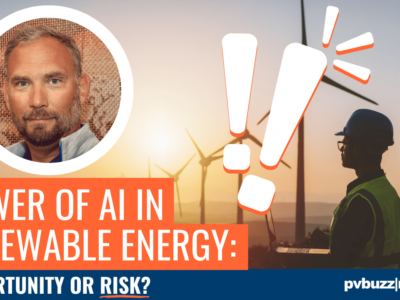Experiments in agrivoltaics have had some promising results over the last year, like using new technology (luminescent solar concentrators) to double food production and implementing AI systems to harvest sunlight better. But is getting twice the use per acre a win-win for sustainable farming and renewable energy?
As our needs for energy and food continue to rise, we’re revisiting the sunny topic of Agrivoltaics – or using land to grow food and host solar panels at the same time. Experiments in this hot space have had some promising results over the last year, like using new technology to double food production and implementing AI systems to harvest sunlight better… But is getting twice the usage out of the acreage a win-win? It takes a certain type of veggie to thrive in these environments, and the upfront costs for this technology can be crippling. Can tech and AI enter and reshape the food production industry, as they’ve done for so many others?
From growing cannabis faster with LSC panels to creating autonomous solar panel cars that can navigate the intricacies of farmland, new developments in agrivoltaics are making waves and even expanding the definition of the field. We’re about to go on a deep dive about the latest advancements, but if you’re looking for a broader explanation of the topic, you may want to check out my previous video called “Solar Panels Plus Farming? Agrivoltaics Explained.” For now, let’s briefly recap why this field is booming.
The Department of Energy predicts that by 2050, ground-based solar technologies will require about 10 million acres of land to produce the power we need to reach our decarbonization goals. That’s the equivalent to about half a percent of the total space across the contiguous United States.
Despite that huge number, researchers aren’t too worried about setting aside land with optimal conditions, and one big reason behind that is Agrivoltaics, or getting dual use out of the land for both food and energy production.
While using open space just for solar farms could run into opposition because it overlaps with prime sites for agricultural work, a study run by Michigan Technological University in 2021 found that over 80% of respondents would be more likely to support solar development in their community if it combined the production of both energy and agriculture. In fact, in June of last year China banned the use of farmlands exclusively for energy production but allows it in special cases where it’s being used for food production too (i.e. agrivoltaics).
This lands us on why Agrivoltaics works and the mutual benefits for both plants and mankind. While plants need sunlight to grow, after a point, more light leads to diminishing returns — it can dry them out instead of contributing to photosynthesis. Solar panels placed above these crops can both absorb the extra light that would otherwise be wasted throughout the day, and provide some shade for the crops to drop temperatures and offer a break from the heat.
All this translates into less water usage for the farmers, saving them money while doubling their land use. It can also increase yield for certain types of plants, like tomatoes, and help farmers diversify their income with a new type of cash crop … energy production.
But this is where it gets really interesting. What if we were to use AI to track weather patterns, measure and optimize crop growth, and even use the panels to protect these crops from dangerous weather? How far could we push this? First, let’s take a look at recent developments in the field.
Government-sponsored policies, like the one in China that I mentioned earlier, have helped push Agrivoltaics projects in countries across the world. From rewarding state-sponsored contracts in France for energy producers, new laws like the Renewable Energy Act in Germany, and published Guidelines for the Design, Construction and Operation of Agrivoltaic Plants in Italy, everyone wants in on the action. There have also been some major advancements for promising tech in the field.
While Luminescent Solar Concentrators, or LSC panels, have been around and evolving for decades, they recently made some pretty big waves in Agrivoltaics. LSC panels are semi-transparent, meaning sunlight passes through them. While that light is travelling through the panel, some of it is captured and concentrated along the edges, where a photovoltaic cell converts it into electricity.
You can probably see where I’m going with this. Combining LSC panels and crop growth holds promise for some electrifying and…(mostly) clear wins.
The new concept of “Agri-LSC”, or using LSC panels specifically with greenhouse architecture, was presented in the Solar Energy journal just in October. The idea of Agri-LSC is to allow visible light that crops use for photosynthesis to pass through the panel, while capturing wavelengths of light that are unusable for plants, like infrared and ultraviolet, and converting them into electricity or even transforming them to aid with crop growth.
Some companies are even off to the races exploring this already. UbiGro is a transparent film that implements a method of LSCs to increase yield for everything from strawberries to cannabis by up to 20%. They recently teamed up with the solar module company Heliene to add UbiGro film to solar panels, simultaneously generating electricity from low light while aiming to increase plant yield. Fingers crossed it works. We’ll need more food for the munchies… oh…and our growing population… of course…
So, if government backing and new, advanced technologies are starting to enter the scene, what’s the holdup? Probably, to the surprise of nobody, the biggest barrier to agrivoltaic farms is cost.
You’ve probably seen it yourself if you’ve considered installing solar panels on your home. While the cost of solar alone can be expensive, agrivoltaic projects come with an even hotter price tag.
Most agrivoltaic farms that use motorized solar trackers need tracking software that involves complex AI systems. Not emotionally complex, like Bing’s AI chatbot telling a NY Times reporter to leave his wife, but sophisticated systems that utilize custom-made algorithms to optimize UV and crop conditions. This of course adds to the price tag of the set up.
Meanwhile project developers have to jump through hoops to get a farm started. From working with the state to determine a price for any electricity sold, to creating custom development plans, and working through legal issues in a developing field, it takes a lot of time, negotiations, and permitting to get things off the ground. Of course this all translates to costs here, too.8
Finally, if the panels are being horizontally mounted, they need to be above a certain height in order to allow farm equipment to pass underneath them and harvest crops. This leads to more material needs, and the mounting structures for these panels are not yet mass produced, so they’re harder to find and more expensive to create (at the moment).
In a study quoted by the department of energy, researchers in Germany estimated while ground-mounted panels costs an average of €572/ kW ($611) and a required investment of €486,200/hectare, ($519,781) an agrivoltaics system with elevated modules cost €1,234/kW ($1,319) and an investment of about €802,100/hectare ($857,565). Almost double the cost of the original.
Now these numbers seem really high compared to what we saw in our previous video on Agrivoltaics, where a study in Applied Energy quoted the difference as just 10 – 20%. The costs seem to range wildly, and this comes down to everything from steel prices, adjusting materials to handle geographical problems like wind, labor costs, and safety precautions. Different vendors will provide hugely different estimates, impacting where and when the projects can start. 91 It’s also still early days for agrivoltaics and new things like this usually start out expensive and drop in cost over time.
But these high numbers limit agrivoltaics system developments and testing in countries with smaller economies, not only restricting who can start an agrivoltaic farm, but preventing additional research the field needs to develop.
Speaking about limited research, it’s worth mentioning that we’ve only found ways for certain crops to benefit from Agrivoltaics so far. Shade-tolerant crops, such as lettuce, chiltepin peppers, and tomatoes saw increased yields in a 2019 study from the University of Arizona by up to 300%. However, other crops like grain, watermelons, or corn want to be in the sun most of the day.
And then there are some more finicky crops that really need a specific amount of light and shade throughout the day. So, let’s throw some shade on those plants. How does AI measure, optimize, and protect crops? Let’s ask.
Hey! Chat GPT. How do we optimize that sun, shade and moisture for every type of plant? Okay… it’s not that simple. But AI is helping us improve growing conditions in agrivoltaic farms.
The past year for AI has been nuts. From an industry associated with reading voiceovers, we’ve landed where AI writes term papers, creates art, and even produces culture. Okay… maybe “culture producer” is too generous a name for a meme-making robot. But the rise of AI can’t be denied. It’s no wonder this tech has entered the world of Agrivoltaics and helped level it up.
Although sensors have been built into solar panels since the beginning, algorithms are now being used in agrivoltaic farms for everything from keeping crops warm at night to deploying nets to protect them from pests. Of course, they’re also measuring sunlight and using data to adjust to different crop’s needs too.
One company leading the pack with this technology is Sun’Agri. Sun’Agri says their AI system can determine the ideal tilt of panels according to sunshine and water requirements, then adjust to the growth model of the crop, soil quality and weather forecasts throughout the day. Just last year they launched an experimental project worth €2.5 million across an area of 4 hectares, including mounted solar panels that automatically deploy nets to protect apricots, cherries and nectarines from hail storms.
Many of the planning details, or rather, annoying drawbacks, we spoke about earlier are solved by the company, by assigning a rep to work through administrative procedures. And to prove their results, Sun’Agri sets up a control plot on your land so you can compare yield and results, which is a cool little feature that can help push research in the field further.
Sun’Agri’s claim to fame comes from a 2019 experiment in which the dynamic agrivoltaic system was used to cover French vineyards under threat from climate change, spring frost, and rising temperatures. 280 panels with a generation capacity of 84 kW were placed above the vineyard that measured conditions and adjusted the amount of light the vines received throughout the season.
Even through heat waves in 2019, the grapes grew normally and water demand was reduced by 12-34% for the sheltered vines thanks to a reduction in evapotranspiration – which is water evaporating from the soil and transpiring from plants.
It’s also claimed that the aromatic profile of the grape was improved in the agrivoltaic farm, that the grapes produced 13% more anthocyanins – red pigments – and were 9-14% more acidic. I’m not exactly a wine connoisseur, so we’ll have to trust the experts on all this, but if AI has the potential to make our food taste even better, I’ll toast to that.
Okay, so we spoke a lot about how solar panels can be mounted above crops and tilted accordingly to optimize the amount of light the plants get throughout the day thanks to AI systems. But what if we used a simpler technology to constantly move the panels around instead, so that optimizing light became less of a concern?
H2arvester has created a carbon neutral “solar car”, basically a group of solar panels on wheels, that autonomously move around a farmer’s land and generate sustainable energy throughout the day. It can navigate ditches, fields and tall grass, and since it rotates between plots of land, it has potential to be used for different types of crops that overhead solar panels can’t yet benefit.
The team is marketing H2arvesters as an additional crop that farmers can add to their repertoire, again doubling the use of the land they own, without impacting their crop yield.
The solar cars store energy as hydrogen, which the company claims will refund farmers on their purchase over time as they sell the energy. After the hydrogen is collected, it’s eventually used for clean energy. It can be sold to third parties, agricultural cooperatives, energy corporations, industries, or even used by the farmers themselves.
The potential for agrivoltaics, advancements in the field, and AI implementations have been promising. But there’s still a ways to go when it comes to fully deploying these systems and putting them into practice. While the technology has evolved over the last couple years, and new policies are starting to make the push, it still may take some time for agrivoltaics to become more mainstream. Win-win scenarios can happen, but it’s going to take some serious investigation into how to best optimize agrivoltaics for different plants, people, and regions.













Comments